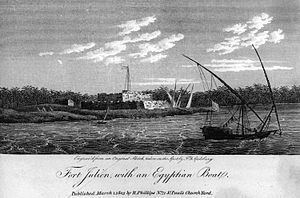306 2,000 | 41 killed or wounded264 surrendered 10 casualties | |
 | ||
Similar Siege of Cairo, Battle of Mandora, French Revolutionary Wars, Battle of Abukir, Battle of Heliopolis | ||
The Siege of Fort Julien was a military engagement that took place during the French Revolutionary Wars as part of the French campaign in Egypt and Syria from 8 to 19 April 1801. The action was between a British and Ottoman force numbering 2,000 men and a besieged French force of 300 men.
Events
The French took possession of a fort on 19 July 1799, only a few days before the Battle of Abukir, and embarked on a hasty rebuilding. It was subsequently reconstructed and was renamed Fort Julien after Thomas Prosper Jullien, one of Napoleon's aides-de-camp. It was during this reconstruction that the Rosetta Stone was found. Fort Julien was an important link in the French defensive line on the route to Cairo and barred access from the sea to the lower reaches of the river. French gunboats operated along the river nearby, blocking access to the mouth of the Nile.
When the British landed at Abukir Bay on 1 March 1801, Baron Charles De Hompesh was sent by General John Hely-Hutchinson to capture Rosetta. Fort Julien was garrisoned by a total of around 300 men, comprising a unit of veterans or invalides supported by artillery and infantry from the 61st demi-brigade.
The British marched on Rosetta on 8 April, accompanied by an 1,000 Ottoman troops, and pushed on to besiege the fort with the 2nd (The Queen's Royal) Regiment of Foot under Lord Dalhousie.
The siege was complicated by the difficulties of bringing artillery to bear on the fort, a task which took eight days. Seven gunboats had to be dragged for 5 kilometres (3 mi) across sand and mud before they could be relaunched on the Nile. While 24-pound naval carronades were landed on the sea shore and dragged 6 kilometres (4 mi) overland to reach their firing positions. General Robert Lawson of the Royal Artillery took the decision to use naval cannonades rather than heavier standard 24-pounders in the assumption – which proved correct – that the cement used by the French in their hasty improvement work would not yet have hardened. The French gunboats were driven back by their British opponents, enabling other British and Turkish gunboats to enter the river.
On 16 April the artillery preparations were completed and the bombardment commenced, focusing on the south-west angle of the fort. A section of the wall collapsed on 18 April, exposing the French defenders to Turkish sharpshooters. The French then waved white flags; and after negotiations the French agreed to surrender.
At 11:00 on 19 April, the 264 surviving members of the French garrison marched out, thus opening the Nile to the British and Turkish fleet. The French suffered 41 casualties, killed and wounded, while the British side suffered the loss of one lieutenant and two privates. Rossetta was subsequently taken without any opposition.
Hutchinson then invested Cairo and on 27 June the 13,000-strong French garrison under General Augustin Daniel Belliard, out-manned and out-gunned, surrendered. General John Moore then escorted them to the coast via Rosetta.
